I get a lot of questions about corsets. Costumers ask what size they should make their corset. Consumers ask what size they should buy their corset. Those with corsets ask how tightly they should lace their corset.
Finally, people ask “Isn’t that horribly painful?”
The answer to that question is an emphatic “No“: not if your corset is well made, properly fitted, and properly laced.
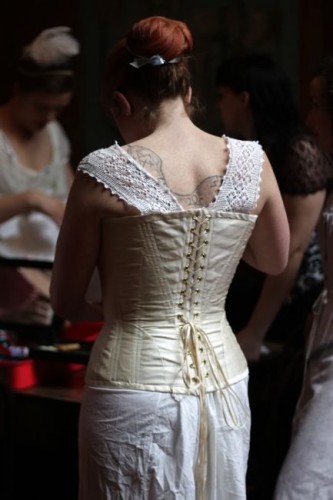
1900s straight-fronted corset at Dr Sketchy
To help with the last two, this is my rough guide to corset fit and lacing. It’s not based on anything more scientific than things I’ve been told, things I’ve noticed in sewing and making corsets, and things I’ve noticed in fitting lots of models in corsets. It’s going to vary depending on the corset style, and on your body. There is no one-size-fits-all in corsets, and no one-answer-fits-all, because there is an infinite variety of bodies.
These guidelines are intended to give a comfortable silhouette with a defined waist and supported bust: something that would be reasonably historically accurate for the period from 1860 to 1900. None of the guidelines here apply to tight-lacing, which, generally speaking, isn’t historically accurate (more on that in a later post).
Size:
For a woman of average build (<10″ difference between waist and hips, <8″ difference between waist and bust, neither athletic nor squishy) I recommend a corset that is 5″ smaller in the waist than the natural waist, and the same size as the natural bust and hips.
For a woman with a very low fat to muscle ration or a very large ribcage, and less bust, waist, and hip definition (this usually, but not always, means a very petite woman), the corset waist measurement should be less than 5″ smaller in the waist.
For a woman with a higher fat to muscle ration, and a curvier body with more bust, waist, and hip definition, I recommend a corset that is more than 5″ smaller in the waist, and bigger than the natural bust and hip size. A squishier body means that it is easier for a corset to safely compress and redistribute flesh from the waist up into the bust and hips (which is why you need a corset that is bigger than the natural bust and hips – they actually grow).
The length of the corset is also very important: it needs to have the right amount of space between your waist and bust, so that your bust is comfortably supported without being pushed up too high, and so that the corset doesn’t chafe under the arms. It also needs to have the right amount of space between your waist and hips, so that the corset doesn’t rub the top of your hip-bones, or poke into the tops of your thighs.
Proportions are also very important: you may have a very flat stomach, or a rounded stomach, hips that jut abruptly or swell in a shallow curve, a flat bottom or rounded bottom, a sway back or straight back, a bottom that has its roundness high or low. A corset that is adjusted for your body will keep these areas from being compressed uncomfortably, or from sitting loosely over them.
In general, the average 19th century woman had a much flabbier, rounded stomach than the average modern woman, because continual corset wearing means the stomach muscles are rarely used to support the torso and hold the stomach in. I find I usually have to take historical corset patterns in in the stomach area, and let them out over the bottom for the corset to sit properly on a modern body.
Lacing:
When you first put on a corset, it’s best to lace it a bit loosely, so that your body has time to adjust to being compressed, and so that the warmth of your body can begin to shape the corset to you. After an half an hour or so you can begin to tighten the laces. If you try to lace a corset to its full extent immediately after putting it on you may experience lightheadedness, difficulty breathing, general pain and pinching, and (most commonly), nausea. Lacing it more slowly is just much more comfortable, and much better for you. Tighten the laces with long, smooth, slow pulls, rather than short, abrupt jerks of the lacing cord.
I prefer a corset to fit so that it laces almost entirely closed at the absolute smallest you would ever want to lace it on its wearer. This just looks lovely and tidy, and keeps you from ever lacing the corset tighter than is good for you or the corset. Most of the time you’ll actually wear it at a looser lacing: with an inch or more of a gap between the two sides of the back. Some people prefer to have a gap in the lacing even with it laced to its fullest extent: that’s just a personal preference.
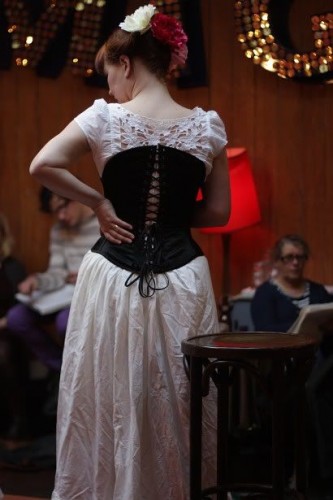
1890s black corded corset at Dr Sketchy
When a corset it fitted properly and laced to the right amount, it should sit snugly and smoothly against all parts of your body. There should be no chance that the corset could begin to slip around your body, or up or down on your body. If your corset pinches or rubs in one particular spot its not fitted properly, if you have trouble breathing in it it’s too small, and if it slips, moves around or doesn’t support your bust, its too big.
In saying all of this, while I do have the luxury of making corsets that fit me perfectly, and fit clients perfectly, I often put my corsets on models, and it just isn’t possible for me to have a custom corset for every model in every era they might wear. I do my best to have a range of corset sizes, to try a range of corsets on each model beforehand to make sure she gets the one that fits her best, and to schedule dressings so that we have time to lace the models in their corsets properly. It doesn’t always happen though. Sometimes I have to call in models at the absolute last minute, and some shows have quick changes. The best I can do is make sure that the corsets are well made and in shapes that fit the widest number of bodies.
Even so, my corsets don’t always fit the models perfectly: there are certainly examples of corsets that are a bit too long in the torso, wide in the bust, too small or too big among these photographs. I console myself by remembering that the average Victorian woman couldn’t afford a custom corset: she just bought a ready-made one, and period photos and wear patterns on extent photographs verify that they didn’t always fit properly.
So a little bit of gaping may not look great, but it is historical! Pinching and discomfort from ill-fitting corsets were probably historical too, but do try to avoid them, because hurting your body and risking your health isn’t worth it, even for historical accuracy.
I hope this helps, and if anyone has anything to add, or different guidelines, or any further questions, please do ask!

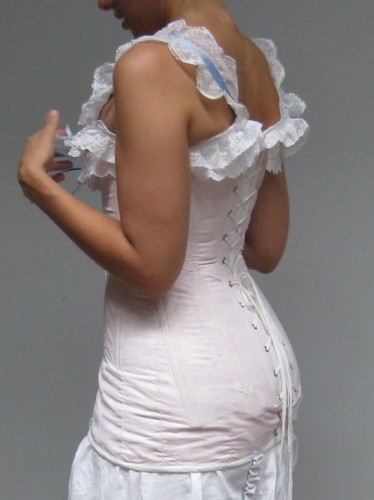
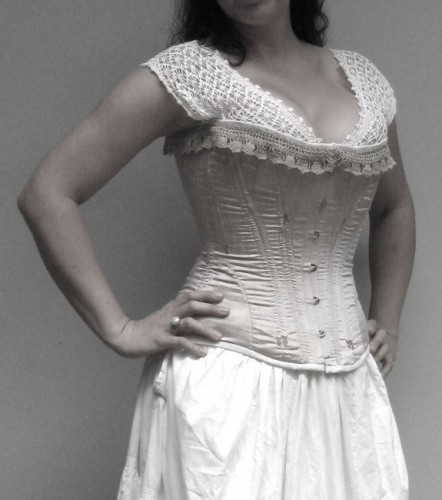
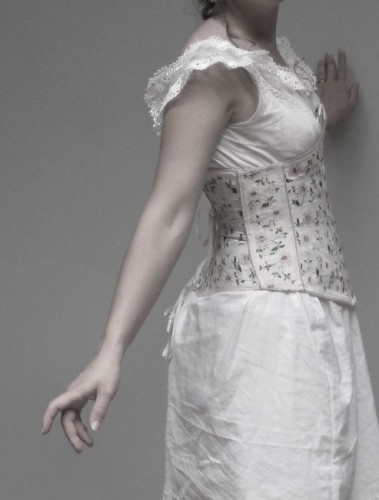
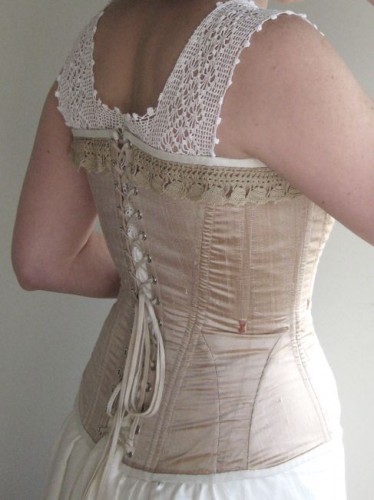

That post was great, really informative! It’s great to hear someone talk rationally rather than hysterically about the actual act of lacing up the corset. Working in bridal taught me that the best way of lacing was much more smooth and gradual than most people thought. So many people have visions of the knee in the back and yanking the laces as hard as possible, but that should be left in Punch cartoons!
PS loving your website, keep it up!
Thanks for your great post about corset fitting! I also did a short series about corsets on my blog (http://mindlessindulgence-mindless.blogspot.de/p/corset-know-how.html) and plan to do a series on how to sew your own corset next. Might take some time to do this, though!
What great timing – I’ve literally just signed up for a corsetry course this week! Thanks, as always, for sharing your wealth of knowledge and experience with us – it’s really appreciated!
My only query is that I’m a weird combination of body shapes: >10 inch difference between waist and hips, 6 inch difference between waist and bust, with squishiness on the hips, but more like average (ha!) squishiness on waist … Would you suggest going for your first option (for the ‘average’ build)?
Great tips on the lacing – I’ll have to show this to my next lacing assistant!!
Hi Clare,
Glad this was helpful. If your waist isn’t going to want to squish a lot then go for the average build. I’m sure the teacher at your corsetry course will have lots of tips and advice too.
Best of luck with your corset!
Thank you, Leimomi! I thought that was probably the case, but wanted to check! I can’t wait for the course – it has a great qualification and teacher. There will be plenty of photos to come of my trials and tribulations with it!
I’ve re-blogged this here http://lauraaftermidnight.wordpress.com/, because you put it so brilliantly!!
I’ve lost count of the amount of times I’ve had to crash across a film set to save an actress from letting another actress do her some real damage by lacing too tightly and too fast… although it has taught me I can unlace a variety of corsets at lightning fast speeds whilst said actress sways faintly in front of me!!
Thank you so much, your blog is wonderful xxx
Thanks for that post on fitting! That’s a very informative bit of information. I usually have my very own special problems with both corsets and stays, as I have a weird waist (TM). I’ve always wondered why most corsets look bulky on me and make my waist look bigger than it actually is, apart from the 19-century-hourglass ones that are meant to reduced the waist considerably. According to most size charts, I’m a normal 12-14 in the bust and hip area, but when it comes to the waist, size 22 and up wouldn’t fit me if I believed them. I don’t have a beer belly *lol* but the whole problem is that I’m a bit hollow-backed *and* my waist is not very defined, i.e. rather straight down from the bustline. No surprise I hate shopping for trousers! So, when I made a pair of 18th century stays, they just looked bulky on my waist. I took out some of the boning at the sides which ended in a slightly better result, but I’m still experimenting with the original pattern to adapt it more to my measurements….(any suggestions on your part would be very welcome 🙂 ).
Haha! I also look funny in corsets! Glad I’m not the only one. Small chest and massive abs from karate create a funny profile so matter what. Like you, I am straight on the sides, and looking for trousers is a pain. After that, the first place I put weight in on my hips. With natural knock-knees, slim bottoms are not a good look.
So I just dress for my body. And I love historical costuming because there is something for everyone. I have an idea: What about early regency fashion? Isn’t there a type of stays from 1800 or so that would look beautiful on your body? Do you enjoy high-waisted dresses in general?
Unfortunately, I don’t like Regency fashion very much *sighs* 😉
Haha! I adore regency, but it looks TERRIBLE on me! We two are so ironic together!
14th and 15th century French or English? The Italian Renaissance also had beautiful high-waisted dresses. And the French classical period, too! Oh! And the German fashions! There are so many ways to look beautiful for each body.
A wonderful post! You have so much experience with making and fitting and wearing corsets. Thank you for sharing.
I was just thinking how funny it is – when I was twenty, I would not have been able to imagine myself ever thinking, “I do wish I’d been able to wear a corset!” I’d only just got rid of the girdle! The difference is that the corset is a choice now, not a rule for all would-be respectable women.
Thank you!
I totally understand about the corset/girdle thing. It’s all about novelty and choice. Corporate wear was such a pain when I had that kind of job, and now when I could wear pyjamas most days I love the chance to pull out the pencil skirts and silk blouses and tailored jackets. Heck, if I lived in Hawaii I might even enjoy the chance to get bundled up in cold-weather clothes again 😉
I often wondered if ladies with larger breasts were more comfortable in (well-fitted) corsets than modern bras. I’ve seen the marks that ‘boulder holders’ leave, and I just can’t believe that a bra has to be a uniform emancipation from a corset. Wouldn’t it be better if the chest was supported by the whole torso?
Really–this is a serious question. I’m teeny tiny up top, and have often wondered the opinion of someone with more curviness, or someone who is in the habit of dressing people with more curves.
I don’t have much experience wearing properly fitting corsets (yet), but I did find that my Regency stays (long ones, not the small bra-style ones) are rather more comfortable than a lot of bras I’ve owned in the past.
That said, there’s a HUGE difference in comfort between a properly fitted bra and what most women wear, especially ones with a larger bust. Part of the issue is that poor fit is perpetuated by poorly trained salespeople at bra shops who recommend going up a band and down a cup so that you can fit in their brand–meaning you have a terribly ill-fitting bra (yes, this really happens). When the band size is too large, especially, you get those marks.
When you have a properly fitting bra (and that size can change even during the month, so you might need multiples), you shouldn’t really have marks, even if your bra is holding boulders, like mine 🙂
Wow–thanks for the information. How funny that there are people more concerned with sale than comfort!
Interesting about going up a band, down a size. Every time I have ever been measured I have been told I’m a 36/14 A. Every comfortable bra that I have ever owned? A 34/12 B. It really is about the exact cut though – some brands just never fit me, they use the wrong template for my body.
I’ve never understood how they are calculated. It seemed quite arbitrary to me.
I was happily wearing a 34DD then got measured and was told I needed a 36EE or a 34F?!? I’m starting to wonder if it was just a trick to get me to buy the expensive bras.
Now the issue I have is once you get over DD all the bras are expensive and *ugly* its like and explosion in a stretch lace factory. I just want a plain T-shirt bra but they don’t do them in my size.
I’m very familiar with the “up a band size, down a cup size” trick. I’ve encountered it so often that I’ve actually become quite suspicious of getting fittings because I’ve been so disappointed with the result so often.
And all my bra straps leave marks in my shoulders…although some more than others.
I’ve often wondered if it contributes to some of the back pain I get…as I find a day wearing a corset usually solves it.
Though the bras are expensive for larger sizes (says the 40DDD/38F, which can at least be found in some stores locally), if you’re left with serious marks on your shoulders, you really are wearing too large a band and forcing your shoulders to bear the brunt of the support.
In a properly fitting bra, it’s the wings (the bits attached to the cups that go around your back) that should be doing the supporting and lifting, which is why the band should be snug. The straps are for holding the cups in place, but not providing much support.
When the band is too large, it slips, causing the straps to dig in, and without the proper support, there can’t be a lot of back pain, I know!
I don’t trust what sales ladies tell me, I learned to measure myself (and have provided the service for very thankful friends and sisters). But Leimomi is also right in that different brands can fit differently. Also, sizes vary across the world-I think UK and US use a similar system, but slightly different measurements, for instance. Basically, it comes down to volume though: a 36A, a 34B and a 32C (US) will all have the same technical volume to hold the boobs in, but the differrent band sizes are going to sit one the rib cage differently and cause it to fit very differently. Up a band, down a cup can work, but when the history lady starts suggesting you do so again, well, you’re getting into seriously ill-fitting territory.
Oops, I meant sales lady, not history.
As a barrel chested woman with D breasts I can say absolutely that my under breast corset provides the support of my breasts and back that I have never had before! I have always slouched and sagged and now I have much better posture and I’m comfortable…finally!! Lol
Wonderful post! I’ve seen various how-tos and discussions that touch on this subject here and there on the internet, but this is the first time I’ve seen a complete, well written guide that covers all the basics in a simple way even corset novices can understand. I’m also a little jealous. Your 1911’s longline corset fits your model MUCH better than my attempt fit me!
Thank you! I appreciate hearing that! I do think it helps that my model (and myself, to some extent) have figures similar to the desired 1910s figure – we’re already shaped like the corset wants us to be shape! (wish I could say the same for 1890s!)
Thanks for the information. Its helped loads. The corset I have is closest to the 1870’s picture.
Your tip about not tightening it straight away applies to me because I’ve had that lightheaded feeling a few times and its made me worry I’ve pulled the laces too tight.
Thank you so much! This makes so much more sense to me than the prevailing thinking that appears to be out there. For Victorian clothing, most sites recommend a two inch reduction overall, which never made sense to me. Having examined period pieces of clothing when I was younger, many fit except for the waist. So I knew that waist reduction was probably the main purpose of the corset. Yes, it changes the shape and posture as well, but often this was also achieved with padding. The only thing that reduces is the corset. And judging by the clothes I’ve seen, some of the waists were so small you knew the proportion of reduction had to be more than two inches, even taking into account the training the body goes through by constant wear of a corset. So two inches of reduction overall never made sense to me. But reducing the waist only, makes so much sense!
Now I’m glad I’ve been putting off making my corset! I will totally rethink how I do it, and it makes so much more sense!
Hi Becky,
Oops! Don’t want to start a mis-conception. A corset that is 5″ smaller than your waist (this is when the corset is laid flat, measured around the waist) isn’t going to reduce your waist 5″. Even the most non-stretch coutil will have some give when pulled tight around your body, and the gap at the back will take up some space. A corset that is 5″ smaller than your waist when flat will only reduce your waist about 3″ even at its tightest.
With most of the historical corsets I have been able to inspect, the bust/waist/hip proportions are similar to modern bust/waist/hip proportions minus 5″. On the fancier corsets the waist is more reduced, on plainer corsets, less. I definitely haven’t done a comprehensive study, certainly not one to challenge the excellent scholarship that has been done in the area. I do not think that the average 19th century corset was meant to reduce the waist more than 2-3″.
Thank you so much for writing this down – in such a concise, down-to-earth manner. I’m sure many will find this useful! Please, continue the series. (You could even create a blog button for people to link to it. ;-))
Thank you! If this was a series what else would you want in it?
I do need to do things like blog buttons. I’d just rather be sewing than fussing with computer stuff. :-p
Perhaps something about fitting issues with various styles of stays and corsets? You know, what you have run into with different body types and different eras? It’s not like everyone has the chance to observe this with different eras and different models, so some five cents from you would no doubt be useful for others. 😉
And I know; I would not know how to do a blog button myself. I even do not quite know how to use it; I usually save the image and put it up on my blog with the link, separately.
Have someone make a blog button for you?
This is a fabulous post! So informative. Do you have any advice on drafting corset patterns or altering commercial ones?
I made a corset from a commercial pattern, it fit horribly and was miles too small. Curvy things are so much harder to get right than cone shaped things, and store bought patterns are evil.
After reading this, though, I am willing to make another attempt at a Victorian corset.
Corsets really are wonderful, it’s sad that so many people think of them as torture devices.
My two cents to add to this discussion is that, in my experience, a pattern with hip gores gives the best results when the difference between waist and hips is greater than 10″.
Excellent post! One of my pet hates is the myth that wearing corsets are horrible and dangerous so I really liked this!
As a person with a lot of squish I can vouch for the need add a little. 🙂
Thank you! That’s a common peeve of mine too (though not as bad as the term ‘flapper’). And I’m very glad to have confirmation that your corset has a lot more curves, and that that measuring theory holds true for you.
I’ve got a 19th century figure then as my stomach is horrible and fat and round. Apple shaped! 🙁
I have a question. I’m 5’0, broad shouldered, large chest, no defined waist or hips, small backside, with a fairly long torso. Which style would you suggest for me? Would love to have a more defined waist, and yes, I’m squishy, lol.
Thank you so much for this article. I had been considering a beautiful corset through Ebay, but as I’ve never been fitted to a corset, and really have no clue if this would fit my body structure, along with no idea on actual fit, I decided to pass on it. Your post made helped me make that decision. I think I’ll wait to purchase a corset until I have a better idea of the actual sizing a corset is.
Hey. My measurements are 46-31-44. I’m half African and have “a black girls bum” aka my hiney starts jutting out before my hips start. Ii was corseting in a 26″ and now in working into a 24″. It refuses to close over the top of my bum which is annoying, will this damage my corset though?
It sounds like your corset isn’t the right size for you – it doesn’t have enough space to accommodate the fullness of your bottom, and where that fullness starts from.
You’ll want to look into going custom for a figure like that. Have a look at Lucy’s Corsetry. She has a wonderful website full of links and guides so you should be able to find someone who offers what you are after.
I myself am 38″, 26″, 38″ and though I don’t *need* to corset because my shape is very much ideal as it is, I do anyway because I like it. I choose my personal corsets to be made with a 6″ reduction and intended to be worn that way (after breaking them in and training down). I find it interesting that I can actually lace to a smaller waist size now than I could when I was 34″, 24″, 34″. Then I could just about manage 22″ measured on top (infrequent wear, corset made with 4″ reduction) whereas now I can lace easily to 21″ on top and I wear my corsets no more frequently. So I used to manage just over a 2″ reduction, but now can manage just over 5″ reduction (measurements inside the corset will be smaller than what is measured on top as the corset itself adds bulk).
Do remember, a corset should NOT stretch. Half and inch to an inch stretch after wearing a corset for 10hrs plus every day for months and months and months may be expected, but they should definitely not stretch out by 2″ as described above. That’s very poor construction if it does that.
This has been the most helpful corset fitting site I’ve found. I’ve had trouble getting the right fit with a smaller bust to waist ratio and you’ve helped me to choose wisely. Thank you so much!
Hi. My under-bust is 23.5, waist, 31 and hip 42. I have a big bum (really big) with some hips. I am pear shape and I have recently looked into waist training because I am going to a huge party in a couple of months and I would like to look my best. However, I do not fit the average size chart and I have found little assistance with my body type. Do you have any suggestions about what kind of corset to buy?
My problem is not getting the corset centered, even when I clip the grommets. I shift it to center but it doesn’t stay there. I end up with a bit of a crooked corset, the bottom is poking to the right of the pelvic area does that make sense? Help!
Does this happen with all corsets, or have you just tried one? My guess would either be the corset is asymmetrical or was cut off the grain (if you’ve just tried one), or you have scoliosis, and your body is quite asymmetrical, making them tilt. Most people with scoliosis have no problem with corsets, and they can even help (they do in my case), but depending on the type of scoliosis they may not work for you. If you do have scoliosis, you should probably discuss your corset wearing with an specialist doctor.
Hi! thanks for all this advice but i am still having problems finding a corset that will fit me. I have actually talked to a lot of sizing experts and they all recommend me getting a corset made just for me, but the problem is i do not have that kind of money to spend on a corset at the moment. I was wondering if you could maybe help me out? My waist is 38″, my underbust is 37″ and my upper hip is 42″. i had ordered a corset from orchard corset and when i laced it up it was fine in the waist area but HUGE in the hip area. I am scared that if i buy another corset from a different company it will just fit like that one did. 🙁
Unfortunately if you have a body that is outside of the standard sizing, the only option for a well fitted corset is usually to get one custom made. I can’t really give any advice other than that 🙁